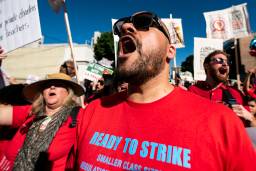If you ask any union activist what went wrong with the labor movement in the last several decades, there’s a good chance you’ll hear about the 1981 PATCO strike. And for good reason: President Ronald Reagan’s harsh response to an illegal strike by federal government employees, members of the Professional Air Traffic Controllers Organization, was interpreted by many as a green light from the federal government for unionbusting, and ushered in the vicious employer attacks of the 1980s.
With his new book Collision Course: Ronald Reagan, the Air Traffic Controllers and the Strike that Changed America, Joseph McCartin, one of the nation’s leading scholars on the decline of the strike, has written the definitive account of the PATCO strike. McCartin details two decades of struggle by often-militant federal employees culminating in the failed 1981 strike. In doing so, McCartin offers new incites into the PATCO strike and pokes holes in some popular conceptions.
Today, many think of the PATCO strike’s impact on private-sector unions. Reagan’s hard-line stance validated a long-allowed but little-used tactic of permanently replacing striking workers. In its 1938 Mackay Radio decision, the U.S. Supreme Court indicated employers were free to retaliate against strikers by giving away their jobs in the event of an unsuccessful strike.
Well into the 1970s, with the labor movement still strong and militant traditions still alive, employers largely avoided using the permanent replacement tactic. Reagan’s hard line against PATCO strikers helped normalize this anti-union behavior, however; in the 1980s, employers routinely threatened to permanently replace strikers, or in fact replaced them.
Even though PATCO is best remembered for its impact on private-sector unions, McCartin’s account reminds us that PATCO was a public-sector strike. As federal employees, PATCO strikers were not legally allowed to strike or even bargain over wages. With the renewed attacks on public employee bargaining rights we’ve seen recently in Wisconsin, Ohio and elsewhere, public-section unionists should find PATCO’s struggle, and Collision Course, instructive.
Indeed, most of the book is spent discussing the decade and a half leading up to the PATCO strike. As McCartin stated in an online discussion of the book:
When I began the book, I had no idea that I would need to take the story all the way back to 1960. But I discovered that there was no way to really understand why the controllers struck in 1981 without explaining the 20 years of struggle and disappointment that led to that moment. The problems they sought to address were many. As I show in the book, they were initially motivated by the desire to make the system safer and to have a voice in policies that would do this – this was something that their employer, the Federal Aviation Administration resisted.
By refusing to provide a legal process of collective bargaining in which controllers could bargain over wages, the federal government helped prompt the strike.
At great risk to their careers, PATCO members repeatedly engaged in slowdowns and thinly disguised sickouts throughout the 1970s. According to McCartin, “Between 1972 and 1977, PATCO emerged as the most militant, most densely organized union in any bargaining unit of the nation’s largest employer, the U.S. government.” Many other federal employee strikes of the period were wildcat actions, disowned by the union leadership. In contrast, PATCO repeatedly organized strikes and slowdowns, going so far as to create a strike fund in 1977.
Not that the going was always easy. Workers were fired, the union lost dues check-off for a period and, without solid collective bargaining laws, gains were eroded over time. Yet PATCO activists fought and built a strong union through the 1970s and somehow usually forced management to get fired strike leaders rehired. As one PATCO slogan put it: “There are no illegal strikes, just unsuccessful ones.” By that, PATCO activists meant that even though labor law did not permit striking, if strikers were strong and united they could defy the ban on striking.
But another lesson of the PATCO strike is that context matters. By the late 1970s, the political terrain was shifting for public employees. In a process similar to today, many Democrats turned on public-employee unions. Indeed, we see in Collision Course that the roots of the PATCO strike lie, in part, in the Carter administration’s failure to reform federal bargaining laws. Frustrated by years of neglect and erosion of hard-won gains, PATCO members were itching for battle just as conditions were worsening for public employees.
In fact, readers will find many similarities to today’s attack on public-employee unions. In the late 1970s, an aggressive union-busting wing of the Republican Party attacked public employee strikes. This wing supplied pressure on Reagan from the right, pushing him to take a hard line against PATCO. Abandoned by Democratic allies, striking public-sector workers found themselves on the defensive. Indeed, McCartin found one of the results of the PATCO strike to be a drastic decline in public-employee strikes.
Unlike PATCO’s actions of the early 1970s, the 1981 strike ended with strikers fired and the union busted. One of the more interesting revelations in Collision Course was that newly elected President Ronald Reagan was not initially gunning for PATCO. PATCO endorsed Reagan and through the threat of a strike, PATCO negotiators were able to negotiate in 1981 what other federal unions saw as a breakthrough contract. But rank-and-file PATCO members, fed up by years of abusive treatment and stress, voted the contract down, and the strike was on.
After decades of union-busting, perhaps Collision Course will prompt a re-examination of the effects of labor law on the decline of our movement. For the last 15 years, the labor movement has largely ignored confronting basic issues of power. Collision Course’s treatment of worker and political power should help inform trade unions’ strategies today, and perhaps prompt discussion of how to revitalize the greatest source of worker power: the strike.
Joe Burns works for the Association of Flight Attendants-CWA. The opinions expressed here are his own.
Joe Burns, a former local union president active in strike solidarity, is a labor negotiator and attorney. He is the author of the book Reviving the Strike: How Working People Can Regain Power and Transform America (IG Publishing, 2011).








